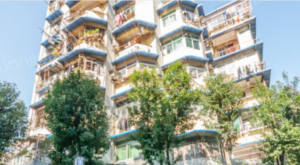Anqing, Anhui Province, China
June 24, 2022 By: Lezi Yan
Location: 29°47\'-31°17\'N, 115°46\'-117°44\'E

I used to live in Anqing, one of the tourist gems of China’s Anhui province, Anqing is an elegant port on the mighty Yangtze river with a long history. In 2015, the city was rated as a national historical and cultural city, a national garden city, an excellent tourist city in China and one of the “Most Internationally Influential Cities” in China by the China Association of Cities (2010). The name “Anqing” dates from the 17th year of the Southern Song Dynasty (1147) when the name “Deqing Jun” was changed to “Anqing Jun” as the military name, with the meaning of peace and good fortune. After the founding of Anqing, until the end of the Qing Dynasty, it was the seat of Anqing Prefecture and Huaining County, and during the Republican period it was the seat of a special commission.[1]
From the Encyclopedia, I have learned that, in the census and detailed investigation of more than 1,000 mineral sites, the main mineral species in the territory are copper, iron, gold, silver, molybdenum, lead, zinc, cobalt, nickel, uranium, sulphide iron ore, limestone, marble, granite, barite, wollastonite, dolomite, rhodochrosite, phosphorus, glass quartz, graphite, china clay, diorite, rutile, sapphire, diorite, tremolite, serpentine, bituminous coal, anthracite, stone coal, peat, natural gas, mineral water and so on. Proven reserves include copper, iron, lead and zinc, gold, silver, tungsten and molybdenum, cobalt, coal, coal, phosphate, and sulphur. Anqing has more than 70 kinds of mineral resources, including non-metallic deposits of fertilizers, construction materials, chemical raw materials, art craft raw materials and other types of large reserves, which are of high quality. [1] Meanwhile, Anqing has a rich and diverse landscape, with the general characteristics of the low and middle Dabie Mountains in the north-west, the Yangtze River continental dikes in the south-east, and undulating hills in the centre, interspersed with low hills and lakes.
As to the city development, Anqing is located in the north of the river and the geographical contour of the river bank greatly limits the expansion of urban land. Although the western side is in the plain, it is in the southern part of the remaining Dabie Mountain range, which has a small plain area and poor geological and geomorphological conditions; the eastern and northern parts are in the plain and have better geological conditions, thus the eastern and northern sides are the main directions of expansion. [2] Between 2000 and 2010, the direction of expansion can be divided into two periods, with the period 2000-2005 being dominated by expansion to the east and the period 2005-2010 being dominated by expansion to the north. This is characterised by limited expansion in the south and west, slow growth in the east and significant expansion in the north, forming a typical ‘L’ shaped urban geography.[3] Compared to northern cities, Anqing’s urban planning and construction is more constrained by the natural environment, resulting in a fragmented urban perimeter, irregular shape and many gaps within the city.
What makes we proud is Huangmei opera. The openness have provided the necessary soil for the growth of Huangmei opera. Anqing has been the birthplace of many new things since the Ming and Qing dynasties. Because of its geographical location, Anqing has been a migrant area with a highly mobile population. In addition, in ancient times, transport relied on water transport, and Anqing’s access to the Yangtze River and its tributaries made it easy to communicate with the outside world. The advantages of being a place of emigration and transportation have led to the development of open and inclusive values in the Anqing region, which often led to a pioneering trend. In the late Ming Dynasty, Fang Yizhi studied Western science and technology with the Catholic missionaries Tang Ruowang and Bi Fangji; the Tongcheng School was a leading literary school for more than two hundred years in the Qing Dynasty, with disciples at home and abroad; and in the late Qing Dynasty, Anqing became a major town in the foreign affairs movement. [4] These phenomena were not accidental, but rather related to the open cultural character of the Anqing people in those times. In the early years, the tea tune from Huangmei in Hubei spread not only to Anqing, but also to other regions such as Jiangxi.
All in all, Anqing, with long history and rich culture, has made glorious achievements in reform and development on one hand. On the other hand, the comprehensive strength has reached a new level, and the people have a greater sense of access, happiness and security. I believe my hometown will get better and better.
[1] https://baike.so.com/doc/24057550-24640868.html
[2] https://anqing.cncn.com/jingdian/tianzhushan/profile
[3] https://baike.so.com/doc/6183676-6396924.html
[4] https://site.douban.com/107894/widget/notes/138234/note/157204347/